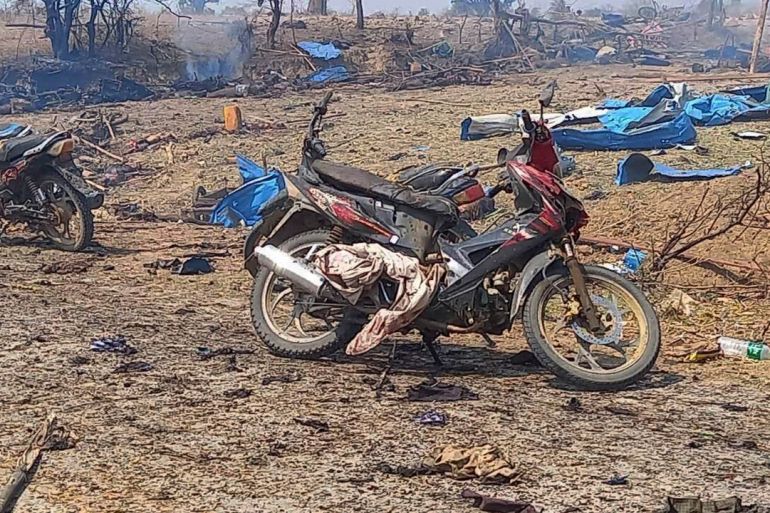Myanmar military used vacuum bomb on opponents: HRW
Rights group claims the military used a thermobaric bomb in last month’s attack on a village in Sagaing, causing ‘indiscriminate and disproportionate civilian casualties’.

Myanmar’s military has used an “enhanced blast” munition known as a fuel-air explosive in an air attack that killed more than 160 people, including many children, at a ceremony organised by its opponents last month, according to Human Rights Watch.
The weapon, also known as a thermobaric or vacuum bomb, killed more than 160 people when it was dropped on the gathering in central Sagaing region, Human Rights Watch (HRW) said in a report on Tuesday.
Keep reading
list of 4 itemsSingapore, Indonesia condemn attack on diplomats in Myanmar
Myanmar military commutes 38 death sentences as part of amnesty
Myanmar to free more than 2,000 political dissidents
About 300 people were at the even to mark the opening of a local office of the country’s resistance movement outside Pazigyi village on the morning of April 11.
The New York-based group said the attack caused “indiscriminate and disproportionate civilian casualties in violation of international humanitarian law, and was an apparent war crime.
“The Myanmar military’s use of a weapon designed to cause maximum deaths on an area crowded with civilians shows flagrant disregard for human life,” said Elaine Pearson, Asia director at HRW.
“Foreign governments need to cut off the junta’s funding, arms and jet fuel to deter further atrocities.”
Thermobaric weapons consist of a fuel container and two separate explosive charges, with the first detonating to disperse the fuel particles and the second igniting the dispersed fuel and oxygen in the air, creating a blast wave of extreme pressure and heat that creates a partial vacuum in an enclosed space.
Human Rights Watch said that it reviewed 59 photos of the victims’ bodies and a video of the site following the attacks, and concluded that the initial attack was conducted with a large, air-dropped “enhanced-blast” type munition.
“The scale of the blast and thermal damage to the building, as well as the profound nature of the burns and evident soft-tissue and crushing injuries suffered by the victims, are distinctive,” the organisation concluded in the report.
The Myanmar military claimed responsibility for the air attacks on the same day on state media but defended its actions. It said the People’s Defence Forces (PDF) – a network of armed groups established by the National Unity Government (NUG) – had “terrorised” residents into supporting them by allegedly killing Buddhist monks, teachers and others.
A military spokesman, Zaw Min Tun, said that the attack targeted PDF members and that the casualties were a result of the attacks hitting PDF storage units for explosives and landmines, which then exploded.
Human Rights Watch said that according to a witness, the People’s Defence Forces stored goods, funds, medicines and also some ammunition in the office building, which was intended for civilian uses such as filing taxes, township meetings and judicial processes.
The National Unity Government, which includes elected lawmakers thrown out of office in the coup, said those killed were mainly civilian residents of Pa Zi Gyi, including 40 children. The NUG says it is the country’s legitimate government.
“The presence of opposition combatants and ammunition would make the building a legitimate military objective subject to attack,” said Human Rights Watch.
“The initial strike and ensuing attacks on hundreds of fleeing civilians was almost certainly an unlawfully disproportionate attack, and possibly a deliberate attack on civilians.”
Myanmar is racked by violence that began after the army overthrew the elected government of Aung San Suu Kyi in February 2021, and brutally suppressed nonviolent protests.
That triggered an armed resistance and fighting in many parts of the country, with the military increasingly using air attacks to counter the opposition and secure territory.